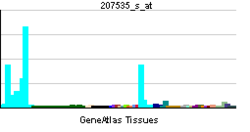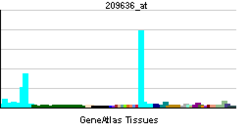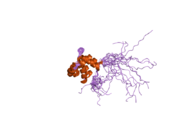- NFKB2
-
Nuclear factor NF-kappa-B p100 subunit is a protein that in humans is encoded by the NFKB2 gene.[1]
NFKB has been detected in numerous cell types that express cytokines, chemokines, growth factors, cell adhesion molecules, and some acute phase proteins in health and in various disease states. NFKB is activated by a wide variety of stimuli such as cytokines, oxidant-free radicals, inhaled particles, ultraviolet irradiation, and bacterial or viral products. Inappropriate activation of NF-kappa-B has been linked to inflammatory events associated with autoimmune arthritis, asthma, septic shock, lung fibrosis, glomerulonephritis, atherosclerosis, and AIDS. In contrast, complete and persistent inhibition of NF-kappa-B has been linked directly to apoptosis, inappropriate immune cell development, and delayed cell growth. For reviews, see Chen et al. (1999) and Baldwin (1996).[supplied by OMIM][2]
Contents
Interactions
NFKB2 has been shown to interact with NFKBIE,[3] BCL3,[4][5] MAP3K8,[6] BTRC,[7][8] RELA,[6][9] RELB,[4][6] NFKB1,[6] REL[6][9] and TSC22D3.[10]
See also
References
- ^ Schmid RM, Perkins ND, Duckett CS, Andrews PC, Nabel GJ (Sep 1991). "Cloning of an NF-kappa B subunit which stimulates HIV transcription in synergy with p65". Nature 352 (6337): 733–6. doi:10.1038/352733a0. PMID 1876189.
- ^ "Entrez Gene: NFKB2 nuclear factor of kappa light polypeptide gene enhancer in B-cells 2 (p49/p100)". http://www.ncbi.nlm.nih.gov/sites/entrez?Db=gene&Cmd=ShowDetailView&TermToSearch=4791.
- ^ Li, Z; Nabel G J (Oct. 1997). "A new member of the I kappaB protein family, I kappaB epsilon, inhibits RelA (p65)-mediated NF-kappaB transcription". Mol. Cell. Biol. (UNITED STATES) 17 (10): 6184–90. ISSN 0270-7306. PMC 232469. PMID 9315679. http://www.pubmedcentral.nih.gov/articlerender.fcgi?tool=pmcentrez&artid=232469.
- ^ a b Thornburg, Natalie J; Pathmanathan Rajadurai, Raab-Traub Nancy (Dec. 2003). "Activation of nuclear factor-kappaB p50 homodimer/Bcl-3 complexes in nasopharyngeal carcinoma". Cancer Res. (United States) 63 (23): 8293–301. ISSN 0008-5472. PMID 14678988.
- ^ Bours, V; Franzoso G, Azarenko V, Park S, Kanno T, Brown K, Siebenlist U (Mar. 1993). "The oncoprotein Bcl-3 directly transactivates through kappa B motifs via association with DNA-binding p50B homodimers". Cell (UNITED STATES) 72 (5): 729–39. doi:10.1016/0092-8674(93)90401-B. ISSN 0092-8674. PMID 8453667.
- ^ a b c d e Bouwmeester, Tewis; Bauch Angela, Ruffner Heinz, Angrand Pierre-Olivier, Bergamini Giovanna, Croughton Karen, Cruciat Cristina, Eberhard Dirk, Gagneur Julien, Ghidelli Sonja, Hopf Carsten, Huhse Bettina, Mangano Raffaella, Michon Anne-Marie, Schirle Markus, Schlegl Judith, Schwab Markus, Stein Martin A, Bauer Andreas, Casari Georg, Drewes Gerard, Gavin Anne-Claude, Jackson David B, Joberty Gerard, Neubauer Gitte, Rick Jens, Kuster Bernhard, Superti-Furga Giulio (Feb. 2004). "A physical and functional map of the human TNF-alpha/NF-kappa B signal transduction pathway". Nat. Cell Biol. (England) 6 (2): 97–105. doi:10.1038/ncb1086. ISSN 1465-7392. PMID 14743216.
- ^ Fong, Abraham; Sun Shao-Cong (Jun. 2002). "Genetic evidence for the essential role of beta-transducin repeat-containing protein in the inducible processing of NF-kappa B2/p100". J. Biol. Chem. (United States) 277 (25): 22111–4. doi:10.1074/jbc.C200151200. ISSN 0021-9258. PMID 11994270.
- ^ Vatsyayan, Jaya; Qing Guoliang, Xiao Gutian, Hu Jing (Sep. 2008). "SUMO1 modification of NF-kappaB2/p100 is essential for stimuli-induced p100 phosphorylation and processing". EMBO Rep. (England) 9 (9): 885–90. doi:10.1038/embor.2008.122. PMC 2529344. PMID 18617892. http://www.pubmedcentral.nih.gov/articlerender.fcgi?tool=pmcentrez&artid=2529344.
- ^ a b Scheinman, R I; Beg A A, Baldwin A S (Oct. 1993). "NF-kappa B p100 (Lyt-10) is a component of H2TF1 and can function as an I kappa B-like molecule". Mol. Cell. Biol. (UNITED STATES) 13 (10): 6089–101. ISSN 0270-7306. PMC 364669. PMID 8413211. http://www.pubmedcentral.nih.gov/articlerender.fcgi?tool=pmcentrez&artid=364669.
- ^ Ayroldi, E; Migliorati G, Bruscoli S, Marchetti C, Zollo O, Cannarile L, D'Adamio F, Riccardi C (Aug. 2001). "Modulation of T-cell activation by the glucocorticoid-induced leucine zipper factor via inhibition of nuclear factor kappaB". Blood (United States) 98 (3): 743–53. doi:10.1182/blood.V98.3.743. ISSN 0006-4971. PMID 11468175.
Further reading
- Schreck R, Albermann K, Baeuerle PA (1993). "Nuclear factor kappa B: an oxidative stress-responsive transcription factor of eukaryotic cells (a review).". Free Radic. Res. Commun. 17 (4): 221–37. doi:10.3109/10715769209079515. PMID 1473734.
- Baldwin AS (1996). "The NF-kappa B and I kappa B proteins: new discoveries and insights.". Annu. Rev. Immunol. 14 (1): 649–83. doi:10.1146/annurev.immunol.14.1.649. PMID 8717528.
- Chen F, Castranova V, Shi X, Demers LM (1999). "New insights into the role of nuclear factor-kappaB, a ubiquitous transcription factor in the initiation of diseases.". Clin. Chem. 45 (1): 7–17. PMID 9895331.
- Bottex-Gauthier C, Pollet S, Favier A, Vidal DR (2002). "[The Rel/NF-kappa-B transcription factors: complex role in cell regulation]". Pathol. Biol. 50 (3): 204–11. PMID 11980335.
- Garg A, Aggarwal BB (2002). "Nuclear transcription factor-kappaB as a target for cancer drug development.". Leukemia 16 (6): 1053–68. doi:10.1038/sj.leu.2402482. PMID 12040437.
PDB gallery External links
Transcription factors and intracellular receptors (1) Basic domains (1.1) Basic leucine zipper (bZIP)Activating transcription factor (AATF, 1, 2, 3, 4, 5, 6, 7) · AP-1 (c-Fos, FOSB, FOSL1, FOSL2, JDP2, c-Jun, JUNB, JUND) · BACH (1, 2) · BATF · BLZF1 · C/EBP (α, β, γ, δ, ε, ζ) · CREB (1, 3, L1) · CREM · DBP · DDIT3 · GABPA · HLF · MAF (B, F, G, K) · NFE (2, L1, L2, L3) · NFIL3 · NRL · NRF (1, 2, 3) · XBP1(1.2) Basic helix-loop-helix (bHLH)ATOH1 · AhR · AHRR · ARNT · ASCL1 · BHLHB2 · BMAL (ARNTL, ARNTL2) · CLOCK · EPAS1 · FIGLA · HAND (1, 2) · HES (5, 6) · HEY (1, 2, L) · HES1 · HIF (1A, 3A) · ID (1, 2, 3, 4) · LYL1 · MESP2 · MXD4 · MYCL1 · MYCN · Myogenic regulatory factors (MyoD, Myogenin, MYF5, MYF6) · Neurogenins (1, 2, 3) · NeuroD (1, 2) · NPAS (1, 2, 3) · OLIG (1, 2) · Pho4 · Scleraxis · SIM (1, 2) · TAL (1, 2) · Twist · USF1(1.3) bHLH-ZIP(1.4) NF-1(1.5) RF-X(1.6) Basic helix-span-helix (bHSH)(2) Zinc finger DNA-binding domains (2.1) Nuclear receptor (Cys4)subfamily 1 (Thyroid hormone (α, β), CAR, FXR, LXR (α, β), PPAR (α, β/δ, γ), PXR, RAR (α, β, γ), ROR (α, β, γ), Rev-ErbA (α, β), VDR)
subfamily 2 (COUP-TF (I, II), Ear-2, HNF4 (α, γ), PNR, RXR (α, β, γ), Testicular receptor (2, 4), TLX)
subfamily 3 (Steroid hormone (Androgen, Estrogen (α, β), Glucocorticoid, Mineralocorticoid, Progesterone), Estrogen related (α, β, γ))
subfamily 4 NUR (NGFIB, NOR1, NURR1) · subfamily 5 (LRH-1, SF1) · subfamily 6 (GCNF) · subfamily 0 (DAX1, SHP)(2.2) Other Cys4(2.3) Cys2His2General transcription factors (TFIIA, TFIIB, TFIID, TFIIE (1, 2), TFIIF (1, 2), TFIIH (1, 2, 4, 2I, 3A, 3C1, 3C2))
ATBF1 · BCL (6, 11A, 11B) · CTCF · E4F1 · EGR (1, 2, 3, 4) · ERV3 · GFI1 · GLI-Krüppel family (1, 2, 3, REST, S2, YY1) · HIC (1, 2) · HIVEP (1, 2, 3) · IKZF (1, 2, 3) · ILF (2, 3) · KLF (2, 3, 4, 5, 6, 7, 8, 9, 10, 11, 12, 13, 14, 15, 17) · MTF1 · MYT1 · OSR1 · PRDM9 · SALL (1, 2, 3, 4) · SP (1, 2, 4, 7, 8) · TSHZ3 · WT1 · Zbtb7 (7A, 7B) · ZBTB (16, 17, 20, 32, 33, 40) · zinc finger (3, 7, 9, 10, 19, 22, 24, 33B, 34, 35, 41, 43, 44, 51, 74, 143, 146, 148, 165, 202, 217, 219, 238, 239, 259, 267, 268, 281, 295, 300, 318, 330, 346, 350, 365, 366, 384, 423, 451, 452, 471, 593, 638, 644, 649, 655)(2.4) Cys6(2.5) Alternating composition(3) Helix-turn-helix domains (3.1) HomeodomainARX · CDX (1, 2) · CRX · CUTL1 · DBX (1, 2) · DLX (3, 4, 5) · EMX2 · EN (1, 2) · FHL (1, 2, 3) · HESX1 · HHEX · HLX · Homeobox (A1, A2, A3, A4, A5, A7, A9, A10, A11, A13, B1, B2, B3, B4, B5, B6, B7, B8, B9, B13, C4, C5, C6, C8, C9, C10, C11, C12, C13, D1, D3, D4, D8, D9, D10, D11, D12, D13) · HOPX · IRX (1, 2, 3, 4, 5, 6, MKX) · LMX (1A, 1B) · MEIS (1, 2) · MEOX2 · MNX1 · MSX (1, 2) · NANOG · NKX (2-1, 2-2, 2-3, 2-5, 3-1, 3-2, 6-1, 6-2) · NOBOX · PBX (1, 2, 3) · PHF (1, 3, 6, 8, 10, 16, 17, 20, 21A) · PHOX (2A, 2B) · PITX (1, 2, 3) · POU domain (PIT-1, BRN-3: A, B, C, Octamer transcription factor: 1, 2, 3/4, 6, 7, 11) · OTX (1, 2) · PDX1 · SATB2 · SHOX2 · VAX1 · ZEB (1, 2)(3.2) Paired box(3.3) Fork head / winged helix(3.4) Heat Shock Factors(3.5) Tryptophan clusters(3.6) TEA domain(4) β-Scaffold factors with minor groove contacts (4.1) Rel homology region(4.2) STAT(4.3) p53(4.4) MADS box(4.6) TATA binding proteins(4.7) High-mobility group(4.10) Cold-shock domainCSDA, YBX1(4.11) Runt(0) Other transcription factors (0.2) HMGI(Y)(0.3) Pocket domain(0.6) Miscellaneoussee also transcription factor/coregulator deficiencies
B bsyn: dna (repl, cycl, reco, repr) · tscr (fact, tcrg, nucl, rnat, rept, ptts) · tltn (risu, pttl, nexn) · dnab, rnab/runp · stru (domn, 1°, 2°, 3°, 4°)Categories:- Human proteins
- Transcription factors
- Chromosome 10 gene stubs
Wikimedia Foundation. 2010.





